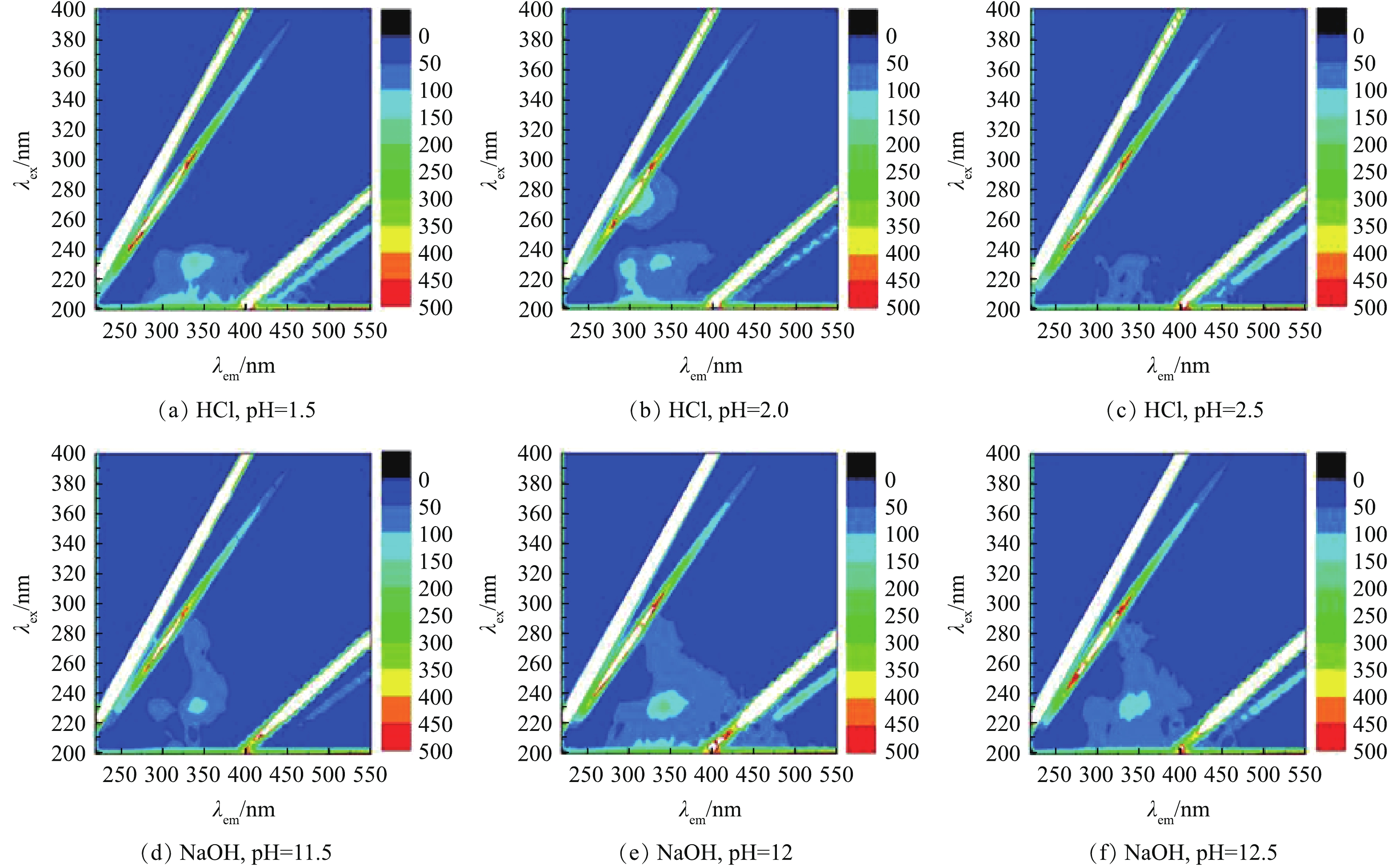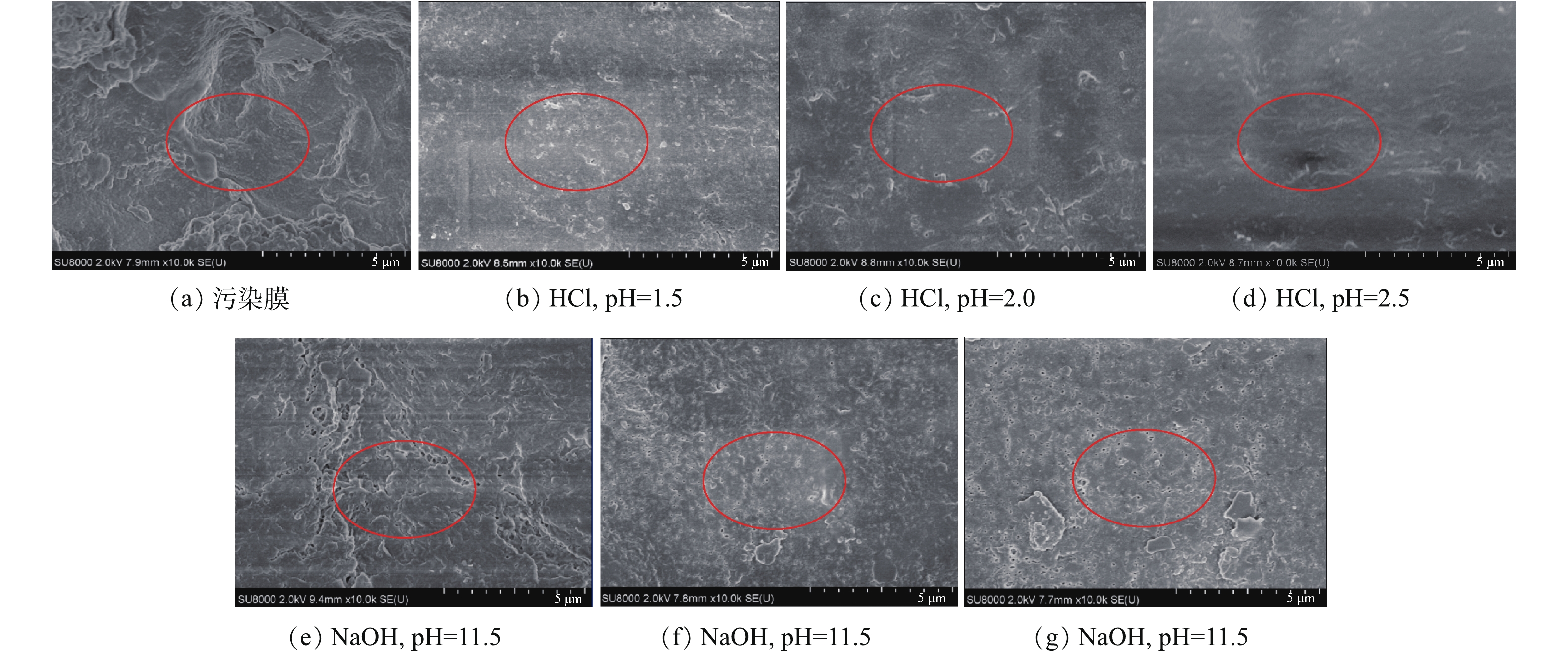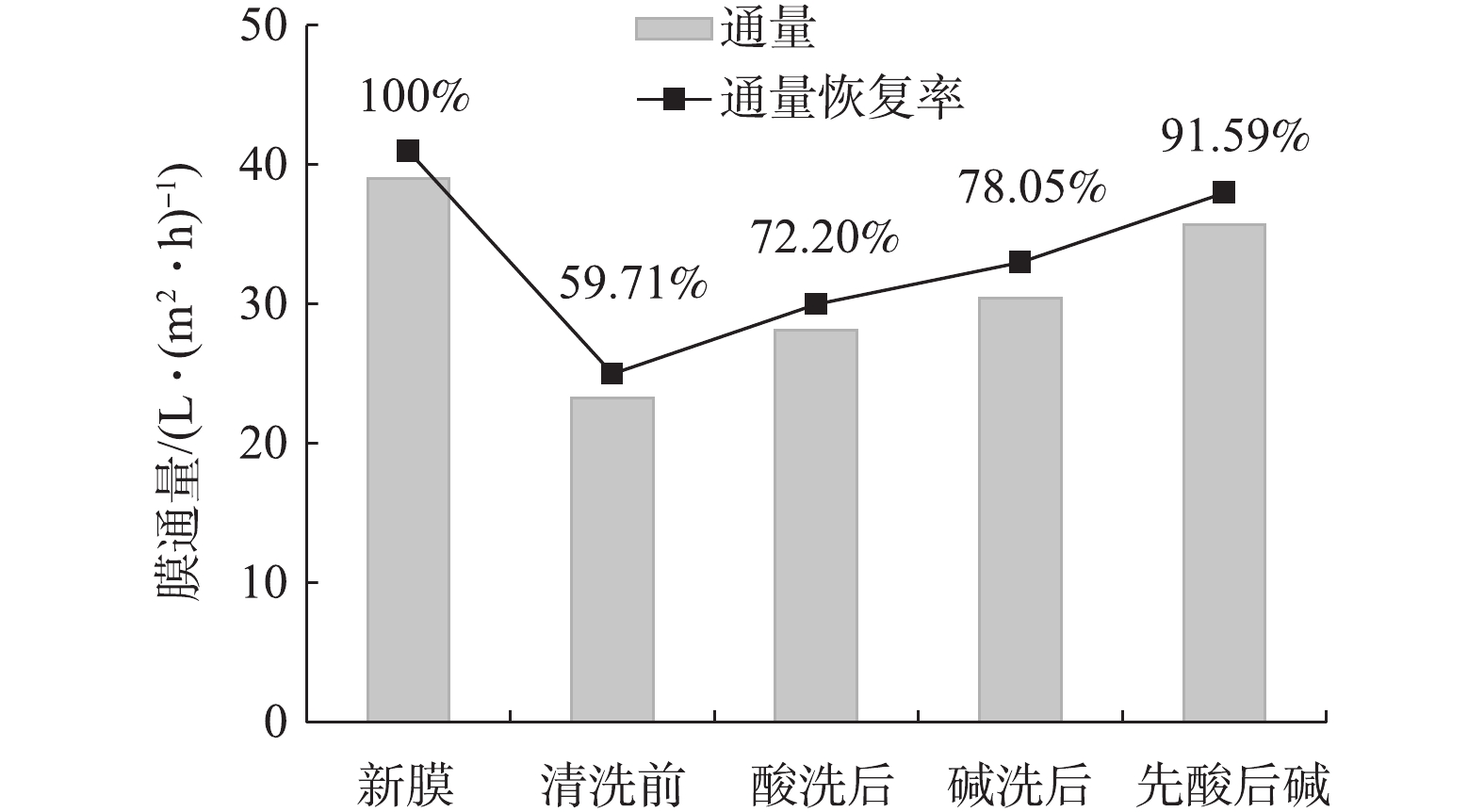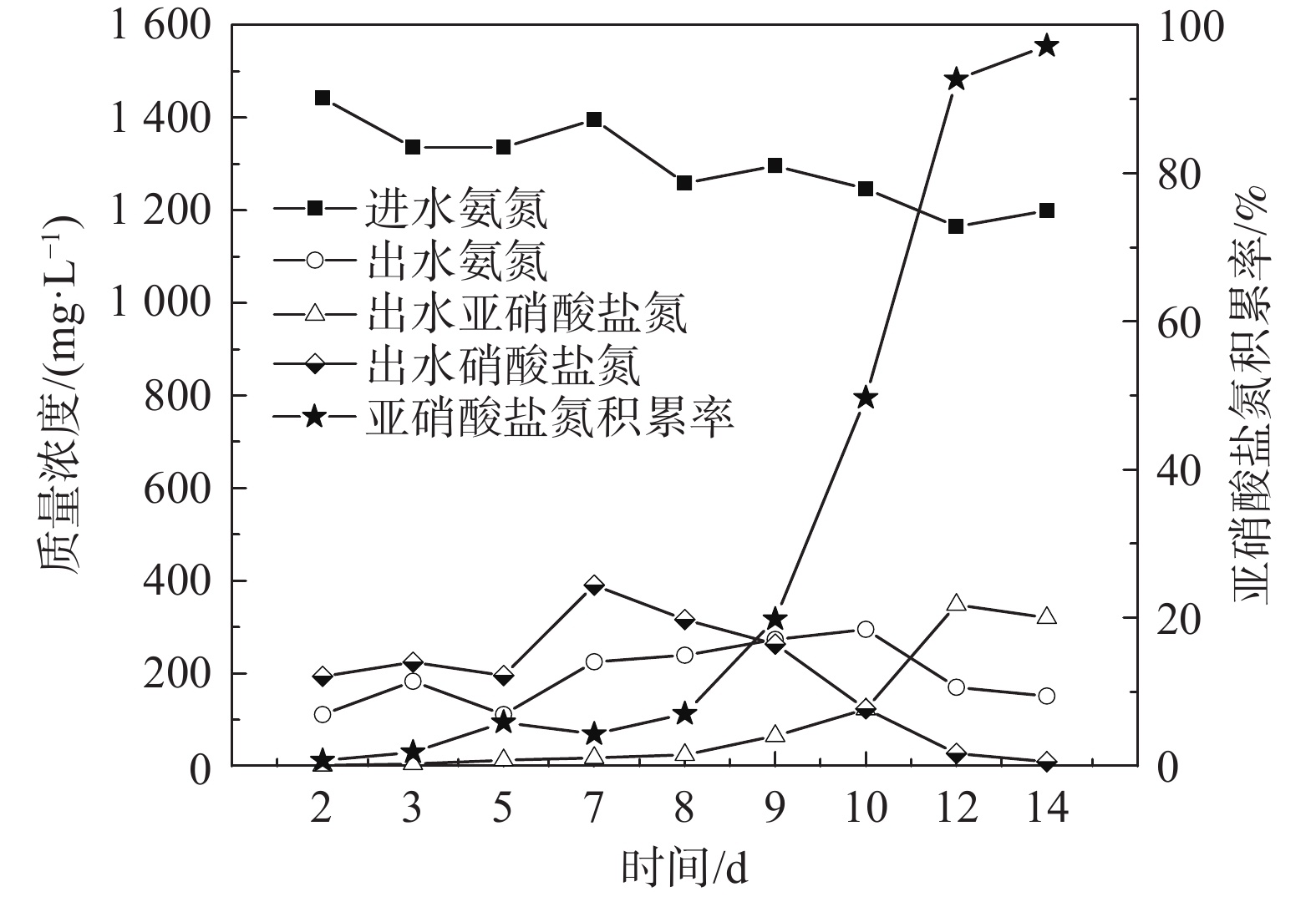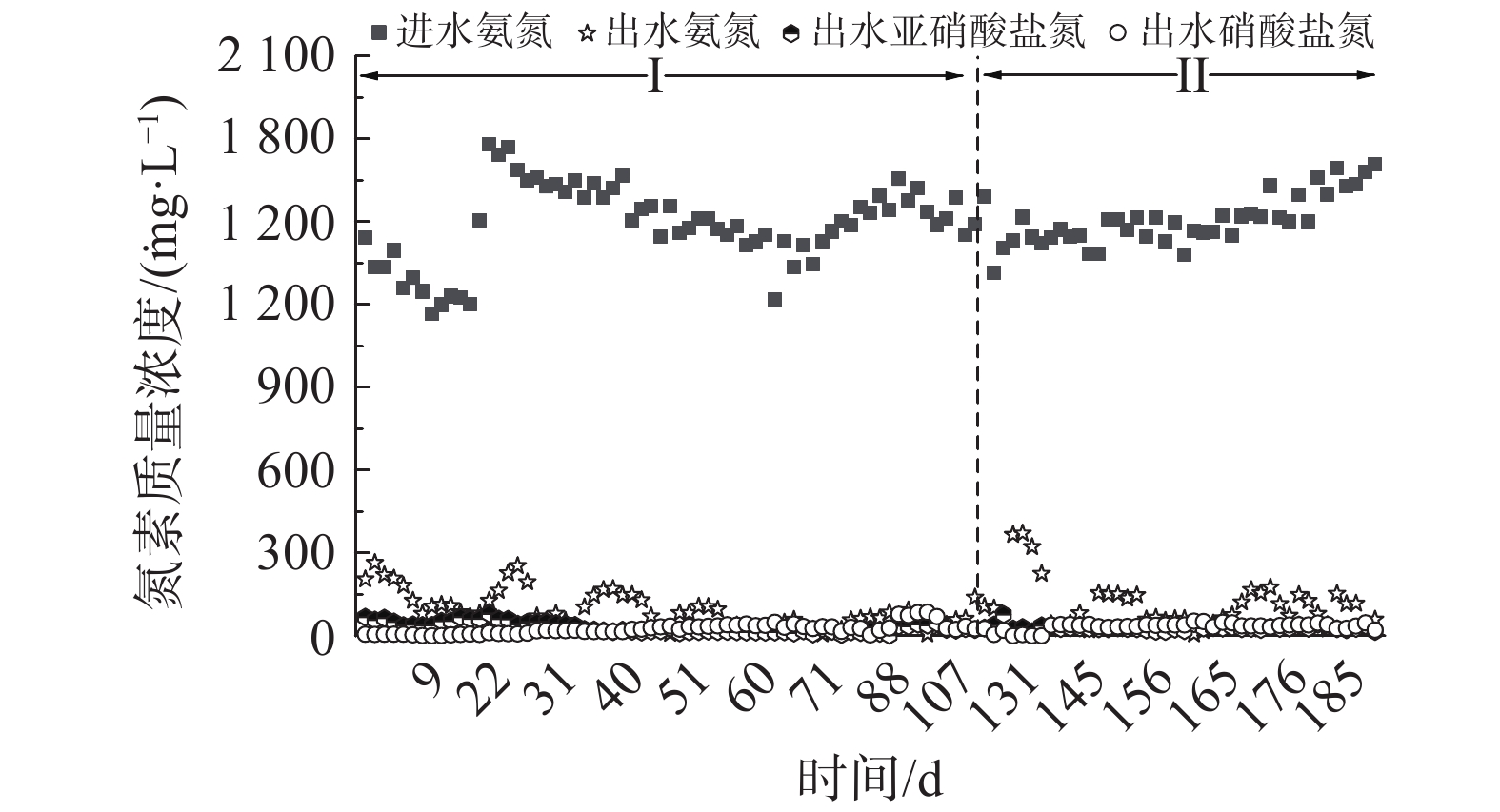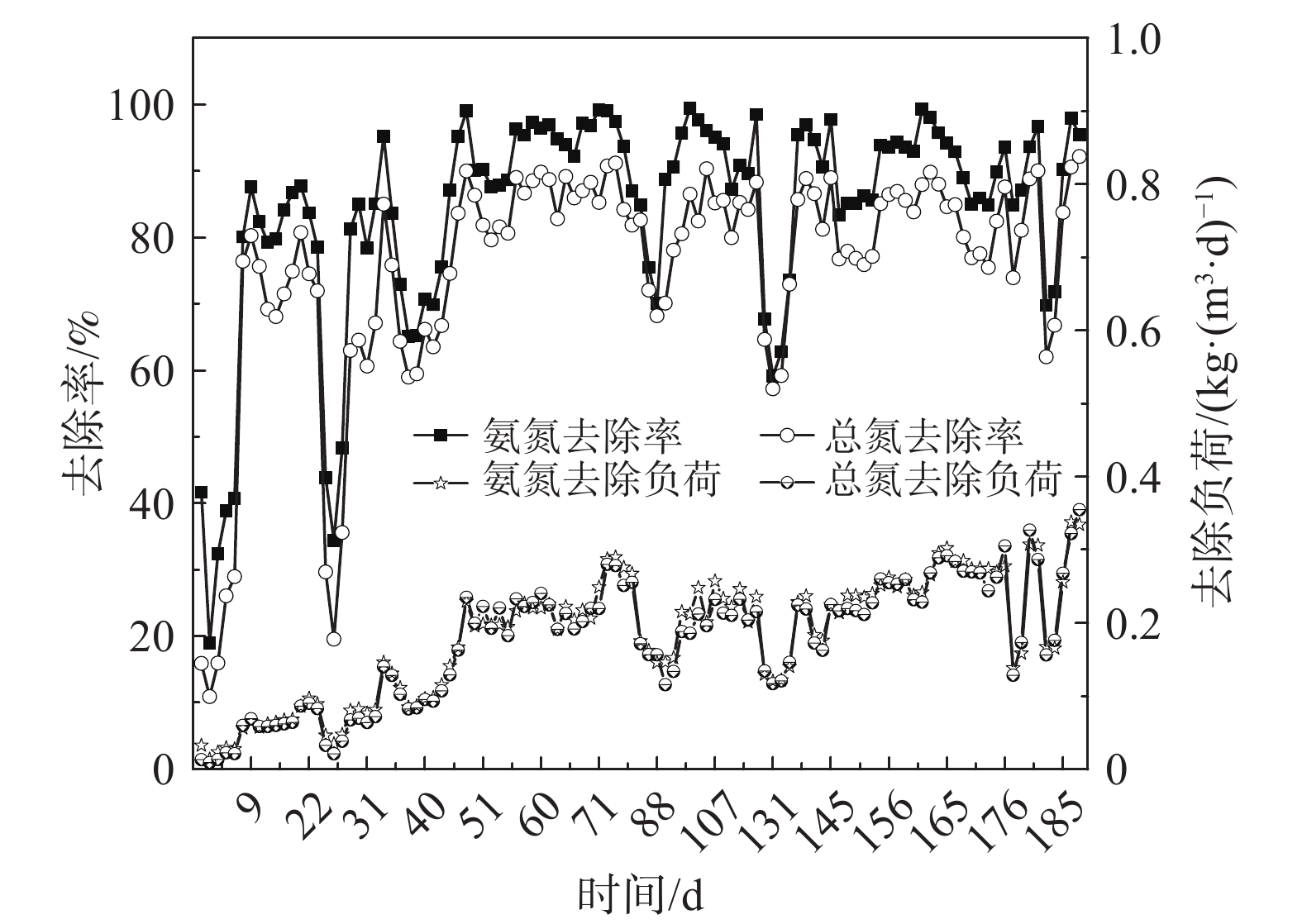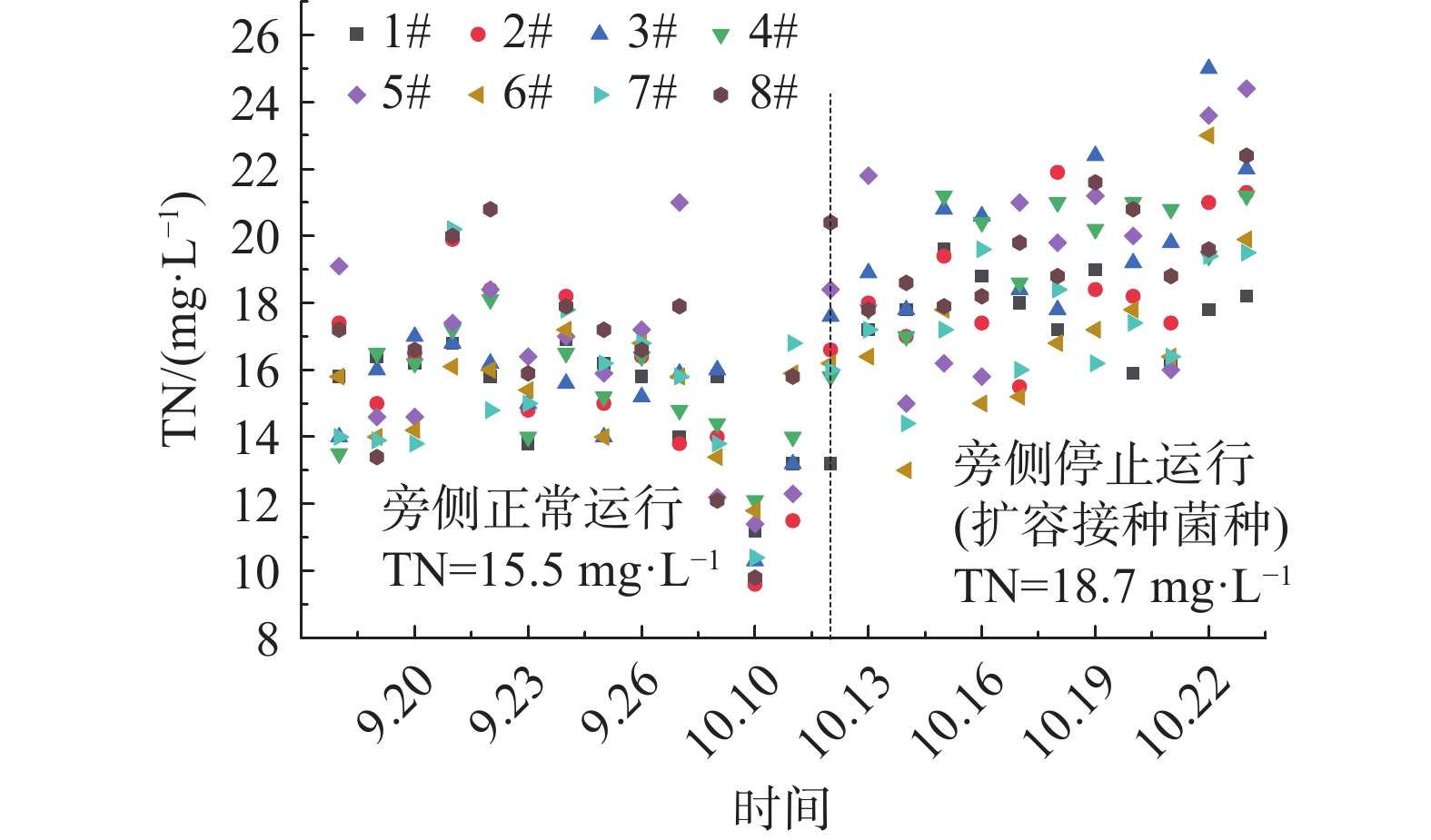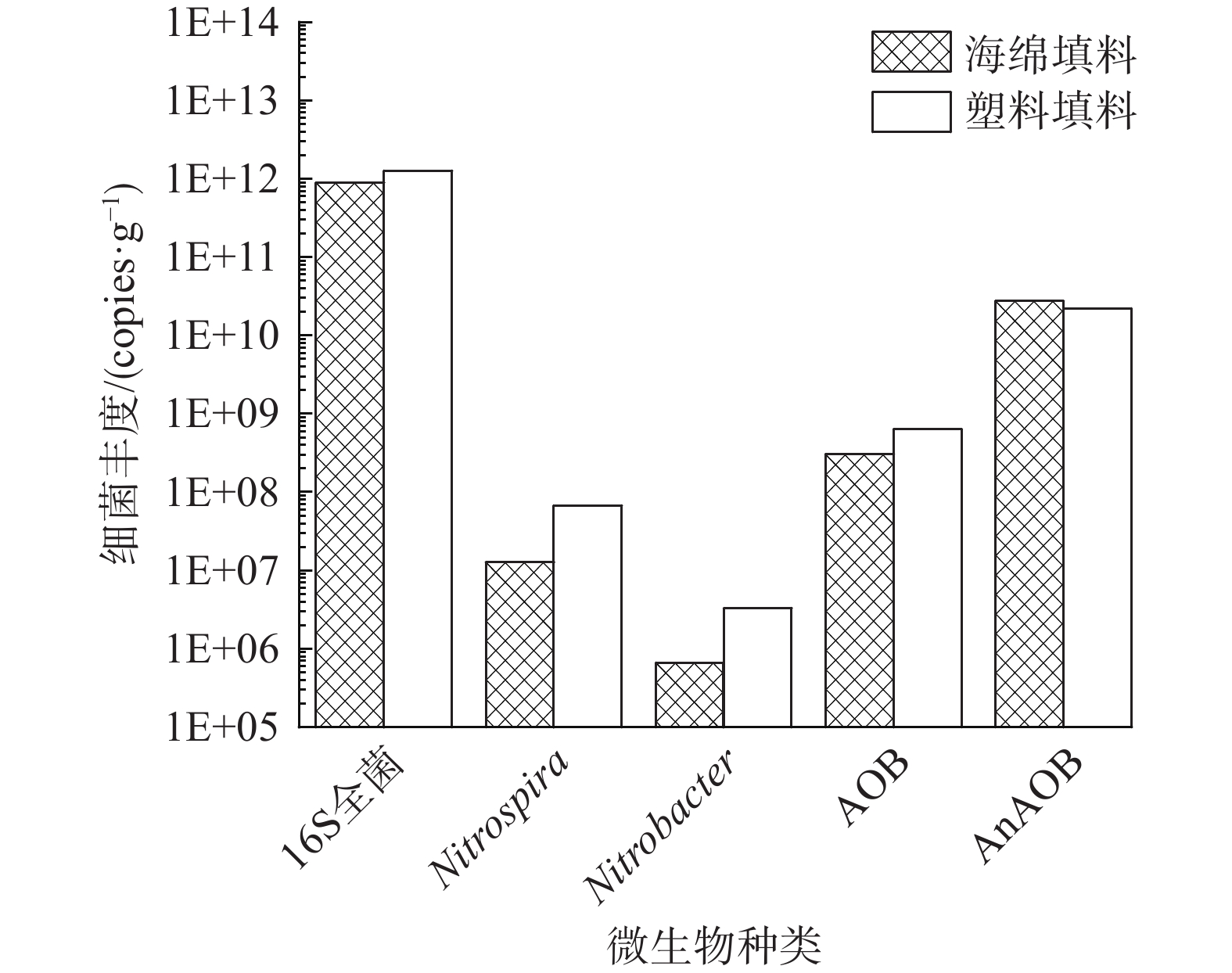-
厌氧消化技术可有效处理污泥并产生绿色能源“沼气”,已成为污泥处理的重要发展方向[1]。在2013年“水环境治理三年行动方案” [2]及产业升级政策的契机下,北京市借鉴国际上大城市污泥处理经验,采取“热水解+厌氧消化+板框压滤+土地利用”的技术路线[3]处理中心城区的污泥,开创了污泥处理处置新思路。热水解技术被广泛应用在厌氧消化预处理阶段,随之产生的热水解厌氧污泥消化液是一种典型的高氨氮废水。此类废水主要指污泥经过热水解预处理及厌氧消化过程后排放的废水,以污泥消化液主。经过热水解预处理后的消化液具有比传统厌氧消化液更加复杂的水质特征,其特点为低CON/N。因此,在其处理过程中,高氨氮浓度、碱度严重不足,以及难降解底物抑制等问题尤为突出[4]。若采取传统硝化反硝化脱氮技术对其进行处理,不仅处理费用高,且出水水质难以保证。
厌氧氨氧化菌(anaerobic ammonium oxidation bacteria, AnAOB)可利用亚硝酸盐作为电子受体将污水中的氨氮氧化为氮气。该脱氮过程仅需将50%的氨氮氧化为亚硝酸盐氮,可节省50%的曝气能耗、50%的碱度消耗及100%的有机碳源,且剩余污泥产量可降低约90%,温室气体排放量减少量大于90%[5-6]。目前,国外已有将厌氧氨氧化成功应用于污泥消化液、养殖废水、垃圾渗滤液等高氨氮废水处理工程的案例[7-12]。热水解厌氧消化液的氨氮高达2 000~3 000 mg·L−1,C/N低于1.5,温度约为30℃。这一水质特点使得其适合采用费用较低的厌氧氨氧化技术进行脱氮处理。然而,有学者通过小试实验发现热水解厌氧消化液中含有的可溶性有机物对氨氧化菌(ammonium oxidation bacteria, AOB)和厌氧氨氧化菌(anaerobic ammonia-oxidizing bacteria,AnAOB)具有较强的抑制作用,经过长期驯化也无法消除此抑制作用。另外,厌氧氨氧化技术应用于热水解厌氧消化液的处理难度更大[13-15],尚无成功案例。
本研究团队在前期研究和实践中已将厌氧氨氧化高效脱氮技术成功应用于城市污水处理厂,并实现了产业化。本研究拟通过启动并调试利用短程硝化厌氧氨氧化(partial nitritation-anammox,PN-ANA)工艺进行热水解厌氧消化液的旁侧脱氮处理工程,深入考察PN-ANA工艺处理热水解厌氧消化液的工艺运行效果,拟评价该技术对城市污水处理厂主流区的影响,并对反应系统内的功能菌群进行定量分析,考察系统菌群的生长情况,以期为该工艺处理高氨氮废水的工程应用提供参考。
-
本项目位于北京某污水处理厂泥区热水解厌氧消化液处理单元内,主体工艺采用连续流固定生物膜-活性污泥(integrated fixed-film activated sludge systems, IFAS)形式的PN-ANA技术。工艺流程为调节池→斜板沉淀池→生化池→二沉池(见图1)。主要反应池(即生化池)的有效容积为7 500 m3,其设计处理水量1 750 m3·d−1。该项目进水氨氮为(1 839±336) mg·L−1,总氮为(2 038±395) mg·L−1,悬浮物质量浓度为≤1 000 mg·L−1,溶解性COD为(2 584±870) mg·L−1。接种污泥为普通活性污泥加上5%填充比厌氧氨氧化挂膜填料。
板框机房将脱水滤液汇集于总管,再通过重力流方式进入调节池,在调节池内停留约10 h进行均质,然后利用提升泵提升至斜板沉淀池。斜板沉淀池设有混凝区和沉淀区,通过投加PAM和PAC去除消化液中悬浮物(suspended solid, SS)及部分COD。斜板沉淀池出水通过重力流方式进入生化池。生化池设有混温区、缺氧区和好氧区。由于AnAOB对环境温度要求较高,为将生化池内水温控制在30~34℃,在其一端引入来自热水解换热器和主流区二沉池的出水。缺氧区内的反硝化作用将进一步提升总氮的去除率,好氧区则是通过曝气,使AOB和AnAOB共同发挥作用,实现消化液中总氮的一次性去除。生化池内泥水混合物经重力流入二沉池后,通过重力沉降作用实现泥水分离。分离后的污泥再回流至生化池,出水则排入厂内退水管线。
工艺的启动与调试分为3个阶段进行(分别编号Ⅰ、Ⅱ、Ⅲ),其中启动含1个阶段,调试含2个阶段。阶段Ⅰ为活性污泥的短程硝化培养阶段(共15 d),即整个工程的启动阶段。阶段Ⅱ进行厌氧氨氧化生物膜的填料接种,即开启系统的运行调试。该阶段主要完成AnAOB的驯化及增殖,为半系列AnAOB生物膜填料接种过程,即仅占用构筑物容积一半(约4 800 m3)来进行,共持续100 d。阶段Ⅲ为全系列调试运行(共60 d),即将已驯化系统扩至容积为7 500 m3的完整构筑物中进行。之后,逐渐将处理水量增至2 000 m3·d−1,超过单系列设计处理水量1 750 m3·d−1。至此,整个工程启动并调试完毕。
采用WTW在线仪表连续监测pH、DO。定期取水样经0.45 μm滤膜过滤后,检测其氨氮、亚硝酸盐氮、硝酸盐氮、溶解性COD等。定期取活性污泥和生物膜填料,并提取DNA,进行荧光定量PCR分析。具体水质检测方法为:纳氏试剂分光光度法检测氨氮;离子色谱法检测盒亚硝酸盐氮和硝酸盐氮的质量浓度;重铬酸钾法检测溶解性COD;重量法检测污泥质量浓度;过硫酸钾氧化紫外分光光度法检测总氮。
-
短程硝化工艺的控制因素有DO、pH、游离氨(free ammonia, FA)、温度、泥龄等[16]。高氨氮废水中较易实现对FA的控制。亚硝酸盐氧化菌(nitrite-oxidizing bacteria, NOB)比AOB更容易受到FA抑制[17],FA质量浓度在1 mg·L−1以上便会对NOB产生明显抑制,但对AOB产生明显抑制的质量浓度则要达到10~150 mg·L−1 。工艺启动期的培养策略为:先通过FA抑制以促进系统中亚硝酸盐的积累;当系统接种普通回流污泥后,保持高氨氮条件下FA的质量浓度大于15 mg·L−1;7 d后,出水亚硝酸盐氮质量浓度达到100 mg·L−1,而系统出水硝酸盐氮质量浓度仍高达300 mg·L−1以上;继续FA抑制7 d后,系统出水亚硝酸盐氮质量浓度达到约400 mg·L−1,此时硝酸盐氮质量浓度持续降低至几乎为零,亚硝酸盐氮积累率达到90%以上,则表明系统顺利实现短程硝化启动。在启动过程中,短程硝化阶段氮素质量浓度及亚硝酸盐氮积累率见图2。
-
接种AnAOB生物膜填料主要来自于处理普通污泥消化液及垃圾渗滤液的厌氧氨氧化系统。由于水质差异明显,且AnAOB生长缓慢,在接种量低的情况下微生物体系的抗冲击能力弱,易导致启动失败。再加上本工程在启动时厌氧氨氧化菌的种类和数量均有限,为保证启动初期系统菌种的浓度,采取半系列启动方式。接种生物膜填料的填充率为5%,生物膜中AnAOB占比高于10%。
图3反映了调试过程中进水氨氮和出水三氮的变化。接种厌氧氨氧化生物膜的初期(前30 d),系统出水氨氮及亚硝酸盐氮质量浓度均在较高水平。出水氨氮波动较大,最高点大于200 mg·L−1,均值为145 mg·L−1;亚硝酸盐氮质量浓度最高值为80 mg·L−1,均值为53 mg·L−1。经过1个月的驯化,系统出水亚硝酸盐氮质量浓度有所降低,均值为20 mg·L−1,但出水氨氮仍有小幅波动,出水均值为88 mg·L−1。接种厌氧氨氧化生物膜2个月后,系统出水三氮明显趋于稳定,且质量浓度维持在较低水平。出水氨氮均值为70 mg·L−1;出水亚硝酸盐氮质量浓度为23 mg·L−1;出水硝酸盐氮质量浓度为37 mg·L−1。
在阶段Ⅱ后期,尽管系统进水水量及处理负荷不断提高,但出水三氮质量浓度稳定且维持在较低状况(见图4)。在接种AnAOB生物膜填料后,经过2个月的调试运行,系统处理水量翻倍达到600 m3·d−1,3个月后处理水量持续翻倍达到1 200 m3·d−1。调试运行4个月后处理水量达到1 600 m3·d−1,总氮去除负荷达到0.25 kg·(m3·d)−1以上。
在阶段Ⅲ,系统已呈现较好的短程硝化厌氧氨氧化效果,于是进行半系列到全系列运行的扩容工作,即将生化池容积从4 800 m3扩容至7 500 m3。扩容方式为将已培养好的厌氧氨氧化生物膜填料直接接种到另外半个系列中。扩容2个月系统稳定后,将处理水量增至2 000 m3·d−1,超过单系列设计处理水量1 750 m3·d−1。此时的总氮去除负荷为0.3 kg·(m3·d)−1。
-
由于AnAOB世代时间长(约11 d),对生存环境非常敏感[18],实现厌氧氨氧化系统的快速启动成为该技术工程化应用中的难题之一[19]。世界上首个生产性规模的两段式厌氧氨氧化装置以消化污泥为种泥,历经3年半启动成功[20]。不同的反应器类型和不同的接种污泥类型亦会影响系统启动时间[21]。本项目在IFAS工艺中接种成熟厌氧氨氧化生物膜(生物膜上AnAOB占比高于10%),在池容5%填充比条件下进行分级培养,并在6个月内成功启动系统,具有重要的参考意义。
系统调试期间总氮和氨氮去除率及去除负荷见图5。氨氮和总氮去除负荷均稳步提升,调试6个月后达到0.3 kg·(m3·d)−1以上。尽管氨氮和总氮的去除率略有波动,但氨氮平均去除率达到86%,总氮去除率达到78%。这表明本项目已实现了PN-ANA技术处理热水解厌氧消化液,进行总氮去除的目标。后期将通过自控系统的改进来改善处理效果波动的问题。
本项目为旁侧处理,处理后二沉池的出水排入厂内退水管线,进入水厂主流区(日处理量100×104 t)进一步处理(见图6)。图6左侧为旁侧PN-ANA正常运行期间(日处理消化液1 600 m3),主流区8个平行运行的二沉池出水总氮变化情况。其中,这8个二沉池运行近1个月的平均出水总氮为15.5 mg·L−1。右侧为旁侧PN-ANA项目施工停运期间热水解厌氧消化液直接排入厂区退水管线后,进入主流区的情况下,主流区8个平行运行二沉池的出水总氮变化。其中,这8个二沉池平均出水总氮为18.7 mg·L−1。这表明日处理热水解厌氧消化液1 600 m3的旁侧PN-ANA工艺可降低主流区二沉池出水总氮约3 mg·L−1,并有效减轻主流区的总氮去除压力。
-
本项目接种污泥为主流区回流污泥,共2 700 m3。2种不同材质(海绵和塑料)的空白填料在阶段Ⅰ被安装至生化池内部。在整个启动和调试的6个月中,将生化池内絮体污泥及生物膜填料定期取样保存,并进行定量PCR分子生物学分析,用数据直观反映系统内脱氮功能菌群的数量变化,以表征系统内功能菌群的培养效果。污泥样品分别为:接种污泥,即污水处理厂回流污泥;分别在项目调试1个月、2个月和4个月时取的污泥絮体;在项目调试4个月时分别在海绵和塑料填料中取样。自调试开始后,絮体污泥中总细菌数及各脱氮微生物数量的关系如图7所示。系统内全菌在活性污泥接种1个月后基本保持不变,维持在1012数量级。这表明系统在不排泥的运行模式下微生物总量趋于稳定。NOB的2个属(Nitrospira和Nitrobacter)数量降低明显,其中Nitrobacter在系统中明显低于其他几种微生物,且一直保持较低水平。这与系统长期保持低DO(<0.5 mg·L−1)运行条件有关[22]。Nitrospira在接种的活性污泥中数量虽略高于AOB一个数量级,但在高氨氮系统FA持续抑制作用下数量不断降低。而随着AOB的不断增长,调试后高于Nitrospira 2个数量级。这表明经过4个多月的调试后,该系统的短程硝化效果良好,可为AnAOB提供大量亚硝酸盐基质。而对于AnAOB,其絮体污泥增长明显,但是绝对数值与AOB仍有2个数量级的差距。
经过4个月调试运行,填料上挂膜微生物数量如图8所示。2种NOB(Nitrospira和Nitrobacter)数量均处于较低水平。而AOB数量略高,达到108数量级以上,AnAOB更是高于1010数量级以上。因此,AOB及Nitrospira 2种好氧菌更倾向于生长在溶解氧及基质较为充足的悬浮絮体中,而厌氧的AnAOB更多分布在溶解氧传播受限的生物膜填料上,如Nitrobacter在本项目中数量很低,几乎可忽略其作用。这亦表明系统内的微生物已适应了环境条件,并基于自身特性及基质获取的难易程度,选择了适宜的生存位置,由此形成了自然选择的系统微生物空间分布[23]。
硝化菌群由AOB和NOB(主要是Nitrospira及Nitrobacter)组成。本项目采用的PN-ANA工艺是利用AOB将部分氨氮氧化成亚硝酸盐氮,再在AnAOB作用下将剩余氨氮和亚硝酸盐氮直接还原为氮气,从而实现污水中的脱氮处理。因此,应尽量抑制NOB在该系统中的活性及其增长,从而促进AOB和AnAOB的活性及增长。本项目调试阶段的4个样品中各种硝化菌占硝化菌群总数的比例见图9。
接种的絮体污泥中NOB(Nitrobacter和Nitrospira)占比较大,接近90%。AOB只占硝化菌群约10%,这符合城市污水处理厂普通活性污泥中硝化细菌的特征。但是,经过1个月的短程硝化培养,AOB所占比例迅速升至95%以上,并随着调试的进行比例不断提高;而以Nitrospira为代表的NOB菌群占比显著降低。这表明该系统内NOB的增殖得到了有效抑制,实现了效果较好的短程硝化,亦与系统进出水水质数据相吻合。
絮体污泥中各脱氮微生物占细菌总数比例见图10。NOB(包括Nitrospira和Nitrobacter)的比例均显著降低。而AOB和AnAOB这2种在PN-ANA过程中发挥主要作用的微生物比例逐步提高。这表明项目经过4个多月的调试,已经很好实现了NOB的抑制、AOB和AnAOB的富集。
-
1)三段式启动和调试步骤保证了本项目循序渐进实现成功运行:在短程硝化阶段采取的FA抑制策略有效促进系统中亚硝酸盐的积累,提供了脱氮功能菌的生存环境,以实现系统启动;在随后两步调试运行阶段,系统通过半系列运行实现了微生物驯化及有效富集,并在全系列运行中逐步达到设计处理水量及稳定运行。
2)工程项目调试运行结果表明:可应用短程硝化-厌氧氨氧化(PN-ANA)工艺实现热水解厌氧消化液总氮去除。在接种生物膜填充比5%,生物膜上AnAOB占比高于10%条件下可在6个月内达到设计处理水量。应用PN-ANA技术进行消化液旁侧处理,可有效减轻主流区的总氮去除压力。
3)项目自调试以来,脱氮功能菌AOB和AnAOB在绝对数量和相对比例上均有较为显著的增加,NOB绝对数量和相对比例均有不同程度的降低,这从微生物角度表明该项目的调试取得了成功。定量PCR数据显示,一体化PN-ANA系统内AOB和AnAOB呈现不同的空间分布特点,AOB主要分布在絮体污泥中,而AnAOB更多分布在生物膜填料上。
PN-ANA技术处理热水解厌氧消化液工艺的启动及运行调试
Startup and operation of PN-ANA technology for treating anaerobic digestion liqui d treated by thermal hydrolysis
-
摘要: 在北京某污水处理厂成功启动了短程硝化厌氧氨氧化(PN-ANA)技术处理热水解厌氧污泥消化液的工艺,并评价了该旁侧技术对主流区的影响。该工艺运行结果表明:在接种生物膜的填料填充比为5%,生物膜上AnAOB占比大于10%的情况下,经过6个月调试运行之后,PN-ANA工艺出水可达到设计指标;总氮去除负荷为0.3 kg·(m3·d)−1,总氮去除率达到78%。估算表明,旁侧PN-ANA工艺可使日处理量为100×104 t水厂的出水总氮降低约3 mg·L−1。另外,通过分子生物学分析发现,工程调试过程中氨氧化菌(AOB)和厌氧氨氧化菌(AnAOB)呈缓慢增长趋势,与处理效果的提升趋势相一致。该工艺成功运用厌氧氨氧化处理热水解厌氧污泥消化液,启动时间仅为半年,可为该技术处理高氨氮废水的工程应用提供参考。Abstract: A practical project of a sewage treatment plant in Beijing was taken as an example to investigate the effect of partial nitritation-anammox (PN-ANA) process on the dewatering liquid of anaerobic digestion pretreated with thermal hydrolysis (THP-AD), and the influence of sidestream PN-ANA technique on the mainstream was evaluated. The operation results showed that when the inoculation amount of biofilm was 5% and the proportion of anaerobic ammonia-oxidizing bacteria (AnAOB) on biofilm was more than 10%, after 6 months of commissioning and operation, the effluent of PN-ANA process reached the design index. The total nitrogen removal load was 0.3 kg·(m3·d)-1 and the total nitrogen removal rate reached 78%.It was estimated that the sidestream PN-ANA technique could reduce the total nitrogen by about 3 mg·L-1 in the eflluent of a water plant with a day capacity of 100×104 t. Meanwhile, the ammonia oxidizing bacteria (AOB) and anaerobic ammonia-oxidizing bacteria (AnAOB) showed a trend of slow growth during engineering commissioning by molecular biology detection, which was consistent with the improvement trend of the project treatment effect. In this project, anaerobic ammonium oxidation was successfully used to treat thermal hydrolysis anaerobic sludge digestion liquid, and the start-up time was only half a year, which can provide reference for the engineering application of this technology to treat high ammonia nitrogen wastewater.
-
随着社会的不断发展,人们对于饮用水水质日益关注,饮用水水质标准也日益严格。传统的饮用水处理工艺已经不能完全达到标准。超滤膜作为一种新型水处理工艺,凭借其占地面积少、出水水质稳定等优点,逐渐被广泛运用于饮用水处理过程中[1-2]。原水中微生物、胶体物质、溶剂大分子可在膜表面和膜孔内沉积、吸附,从而造成膜通量下降的现象[3-6],即为膜污染。过滤一旦开始,膜污染就产生,因此膜污染是无法避免的。
已有研究[7-8]表明,膜污染成为了膜技术发展过程中最主要的制约因素。膜污染使得膜技术在实际运用中出水水质和产水率降低的同时,导致基建、操作、膜清洗等费用的增加[9]。常见的针对膜污染的预防和解决方式通常包含加强膜前预处理、优化操作工艺、对膜污染的清洗以及寻找并研发新型抗污染能力强的新型膜材料和膜组件等。
对污染膜进行清洗是使用较多且较便捷的方式。通过物理清洗和化学清洗可减轻膜污染问题,进而恢复膜的过滤性能[10]。LIANG等[11]在对含藻废水的超滤膜进行化学清洗后发现,与单一清洗剂相比,NaOH和NaClO混合液清洗剂清洗效果更好。MA等[12]将化学清洗与PVDF膜表面改性相结合,提高了膜通量的恢复效果。因此,研究膜污染的化学清洗对超滤工艺的实际运用具有重要意义。
本研究针对江苏某自来水厂的膜污染情况,利用HCl溶液、NaOH溶液对污染膜进行化学清洗。通过对洗脱液的有机化学指标、物质组分、金属离子浓度以及清洗前后膜表面特性的分析,分析膜污染状况并选择适合的清洗剂及其pH条件,以期能寻找出有效的清洗药剂和清洗方法,并应用到实际工程案例中,为解决水厂膜污染问题提供参考。
1. 案例介绍
江苏某水厂是国内首家采用短程混凝和膜过滤组合工艺的自来水厂,使用PVC中空纤维超滤膜,超滤系统设计产水能力为25 000 m3·d−1,共10组膜。每组分为2个膜单元,每个膜单元由26个超滤膜组件组成。每个膜组件的有效过滤面积为35 m2,设计通量为32 L·(m2·h)−1。超滤系统运行中每小时进行30 s反冲洗,水力反洗强度为60 L·(m2·h)−1,曝气强度为90 m3·(m2·h)−1。水力停留时间和污泥停留时间分别为0.768 h和3 h。每2周进行1次维护性清洗,清洗剂为次氯酸钠(NaClO),浓度为200 mg·L−1。超滤膜运行初期,通过水力反冲洗和维护性清洗,能够有效地去除和控制膜污染。但是随着膜系统运行时间的不断增加,膜通量不同下降,膜阻力逐渐增加(图1),污染愈发严重,仅通过水力反冲洗和维护性清洗已经无法保证产水回收率。因此,须进行恢复性化学清洗。
2. 实验材料与方法
2.1 实验样品与试剂
膜丝样品来自江苏某自来水厂的PVC外压式中空纤维超滤膜(立升公司,海南),外径为1.45 mm,内径为0.85 mm,有效过滤面积为0.01 m2,截留分子质量为50 kDa。膜样品表面某些部位肉眼可见附着滤饼层,呈黄色。经湿态保存运输至实验室,使用海绵擦拭除去滤饼后,进行清洗实验。
化学试剂:氢氧化钠(北京化学试剂公司,优级纯),盐酸(上海国药集团化学试剂有限公司,分析纯)。
2.2 污染膜清洗实验
配制不同pH的化学清洗剂:HCl溶液(pH=1.5、2.0、2.5);NaOH溶液(pH=11.5、12.0、12.5)。将膜丝样品等长度分割,浸泡在200 mL不同种类的化学清洗剂中,静置24 h后取出,随后对浸泡液进行成分分析。使用超纯水将膜丝表面的浸泡液清洗去除,清洗过后的膜丝经过冷冻干燥后,对其膜表面特性进行分析。
2.3 水质分析
三维荧光(EEM,F-7000, Hitachi,Japan)用于定性分析所测水样中溶解性有机物的特征。将待测水样通过0.45 μm滤膜,采用氘灯为激发光源,条件为:发射波长λem =220~550 nm,激发波长λex=200~400 nm[13]。发射和激发狭缝宽度为10 nm,扫描速度为12 000 nm·min−1,随后使用软件Origin 8.0进行光谱图绘制。电感耦合等离子体-原子发射光谱(ICP-OES OPTIMA-2000,PerkinEler,USA)用于分析清洗液中金属离子的浓度。
pH采用Meter型pH计(Mettler-Toledo, Switzerland)进行测定。水样通过0.45 μm滤膜后,使用TOC分析仪(TOC-VCPH,SHIMA-DZU,Japan)测定出的结果即为DOC。样品UV254使用紫外/可见光分光光度计(U-2900,Hitachi,Japan)进行测定。通过测定出的DOC和UV254,根据式(1)可以计算出SUVA值。SUVA值为有机物亲疏水性指标[14]。
RSUVA=Auv254CDOC×100 (1) 式中:RSUVA为水中溶解性有机物中含有双键的有机物占总有机物的比例,L·(mg·m)−1;AUV254为水中含有碳碳双键的有机物,cm−1;CDOC代表溶解性有机物,mg·L−1。
2.4 膜表面特征分析
扫描电子显微镜(SEM,LEO-1530, Germany)能够用于直观地观察膜表面的形貌特征,清洗后的膜丝经过24 h的冷冻干燥后,膜表面及膜孔内的水分得以去除,以便于观察。全反射傅里叶红外光谱仪(ATR-FT-IR,Magna-IR 750, Nicolet, USA)用于分析膜表面的官能团,测量波数为600~4 000 cm−1,分辨率为4 cm−1。通过比较新膜与污染膜表面官能团的差异,进行膜污染的分析。
3. 结果与讨论
3.1 污染物成分分析
表1为使用不同化学清洗剂清洗污染膜后,所测得的洗脱液DOC、UV254以及经计算得出的SUVA值。由表1可以看出,相比于HCl溶液,NaOH溶液作清洗剂的洗脱液中DOC浓度更高。这表明NaOH溶液对有机物的清洗效果优于HCl溶液。对比同种清洗剂在不同pH条件下洗脱液的DOC,可以得出,pH=1.5时的HCl溶液的清洗效果要优于pH=2.0和2.5时的效果。这说明HCl溶液的酸性越强,对有机物的清洗效果越好。而采用NaOH溶液对污染膜进行清洗时,pH=12.5时洗脱液DOC大于pH=11.5、12.0时的洗脱液DOC,说明NaOH溶液的碱性越强,对有机物的清洗效果越好。而根据计算的SUVA值分析,相比于NaOH溶液,HCl溶液的洗脱液SUVA值更高,说明HCl溶液洗脱出的有机物以大分子以及疏水性有机物为主[15]。
表 1 洗脱液有机化学指标Table 1. Organic chemical parameters of the eluants清洗剂 pH DOC/(mg·L−1) UV254/cm−1 SUVA/(L·(cm·mg)−1) HCl 1.5 0.287 0.001 0.348 HCl 2.0 0.160 0.017 10.638 HCl 2.5 0.075 0.008 10.681 NaOH 11.5 0.610 0.001 0.164 NaOH 12.0 0.810 0.002 0.247 NaOH 12.5 1.794 0.010 0.557 采用EEM对洗脱液进行物质组分分析,结果如图2所示。采用HCl溶液为洗脱液时,不同pH下特征峰显著不同。当pH=1.5时,仅有一个特征峰,位于λex< 250 nm处,λem为330~380 nm。这说明洗脱液中主要有机物为芳香类蛋白质。当pH=2.0时,特征峰位于λex > 250 nm,λem为280~330 nm;λex < 250 nm,λem为280 ~ 380 nm。这说明洗脱液中主要有机物为溶解性微生物代谢产物及芳香类蛋白质[12]。而当pH=2.5时,没有明显的特征峰。采用NaOH溶液为洗脱液时,无论洗脱液pH为多少(11.5、12.0、12.5),特征峰均在λex < 250 nm,λem在330~380 nm处有类似的特征峰。可以看出,NaOH洗脱液中主要的有机物为芳香类蛋白质[13]。对比这2种洗脱液的响应范围和响应强度,可知NaOH溶液对有机物的洗脱效果更好。这与前述洗脱液有机化学指标分析结果一致。通过对2种洗脱液成分的EEM分析,发现蛋白类有机物是造成PVC中空纤维超滤膜膜污染的有机物之一。
表2为PVC中空纤维超滤膜经清洗剂清洗后洗脱液中Ca、Mg、Al、Si、Fe、Mn的浓度。对于Ca、Mg这2种元素来说,HCl清洗效果较好。而Si元素更容易与NaOH反应形成可溶性硅酸盐,因此,NaOH清洗剂的清洗效果较好。HCl溶液能够与Fe、Mn发生络合,促进Fe、Mn化合物的溶解,因此,HCl对Fe、Mn的清洗效果相比于NaOH更好。针对无机金属污染,2种清洗剂的清洗效果各有利弊。总体而言,HCl的清洗效果优于NaOH溶液的清洗效果。实验结果表明,造成膜污染的无机金属元素主要有Ca、Mg、Si、Fe。
表 2 洗脱液金属离子浓度Table 2. Metal ion concentration in eluates清洗剂 pH Ca/(mg·L−1) Mg/(mg·L−1) Al/(mg·L−1) Si/(mg·L−1) Fe/(mg·L−1) Mn/(mg·L−1) HCl 1.5 0.849 0.357 0.007 0.513 0.447 0.029 HCl 2.0 0.956 0.387 — 0.468 0.174 0.016 HCl 2.5 1.008 0.329 — 0.395 0.107 0.013 NaOH 11.5 0.227 0.118 0.006 0.435 0.048 — NaOH 12.0 0.200 0.180 0.033 1.306 0.060 — NaOH 12.5 0.337 0.269 0.036 2.061 0.084 — 3.2 清洗前后超滤膜表观形貌分析
采用SEM观察膜丝表面形貌。图3为污染膜化学清洗前后PVC中空纤维超滤膜表面的形貌变化。由图3(a)可以看出,污染膜表面覆盖大量污染物,观察不到膜孔的分布。对比使用同种洗脱液在不同pH下的清洗效果发现,采用pH=1.5的HCl溶液清洗后,膜表面污染物最少,膜孔显露且表面纹路分布清晰,说明其清洗效果在3种不同pH的HCl中是最好的;而pH=2.5的HCl溶液清洗的效果相对较差。对于NaOH清洗液,pH=12.5的清洗效果最好。通过对不同清洗剂的最优pH条件下膜表面形貌的观察发现,污染膜经过pH=1.5的HCl或者pH=12.5的NaOH清洗后,膜孔显露较多且相对较为清晰可见。
3.3 清洗前后超滤膜表面官能团分析
采用ATR-FT-IR对清洗前后PVC中空纤维超滤膜膜表面官能团进行表征,结果如图4所示。图4(a)为污染膜,该污染膜在波数1 000 cm−1处有强烈的吸收峰,表明污染膜表面存在多糖或多糖类物质[16-17]。在1 430 cm−1附近的吸收峰显示羧酸C–OH面内弯曲振动,表明存在羧酸类化合物,具体是何物质尚需进一步研究和证实。而在波数为1 737 cm−1处出现的特征峰表明羰基的存在[18-19]。同时,在1 200 ~ 1 300、2 940和3 300 cm−1附近出现特征峰,表明污染膜表面还存在腐殖酸类物质[15]。因此,总体而言,污染膜表面含有多种有机污染物,包含了蛋白类、多糖类和腐殖酸类。与污染膜相比,经清洗剂清洗后的污染膜官能团吸收峰位置变化不大(见图4(b)和图4(c)),而强度会有所减弱,说明污染物种类并没有因为膜清洗而发生大的变化,化学清洗只能去除膜表面部分有机污染物。
3.4 工程应用
通过实验室污染膜的清洗实验可知,采用酸碱清洗能够有效地去除膜表面污染物。由于实验室仅仅是对洗脱液和清洗后膜表面形态变化的分析,并未考察膜通量的恢复情况,而膜通量是考察膜清洗效果最直接和重要的参数,因此,为了更好地评估酸碱对污染膜的清洗效果,在实际工程中分别采用pH=1.5的HCl溶液和pH=12的NaOH溶液对膜污染进行恢复性的化学清洗。同时考虑到酸碱各自清洗效果的不同,还采用先酸后碱的组合清洗方式。清洗后膜通量如图5所示。HCl清洗后膜通量的恢复率为72.2%,而碱洗后通量恢复率为78.05%。清洗结果表明,采用碱洗效果优于酸洗。而采用组合清洗方式,先酸洗后碱洗通量的恢复率高达91.59%,说明组合清洗方式效果更佳。而膜污染是多种污染物共同造成的,仅用一种清洗剂清洗效果并不能获得较高的通量恢复率。由前述结果可知,NaOH能够有效地去除有机污染物和硅离子,HCl则可以去除部分有机物(大分子和疏水性的有机物),同时对钙离子去除效果较好,因此,在实际污染膜清洗工程中,最佳的清洗方式为先酸洗后碱洗的组合清洗方式。
4. 结论
1) 通过对江苏某水厂实际运行的PVC中空纤维超滤污染膜化学清洗后洗脱液的分析可知:蛋白类、多糖类以及腐殖酸类有机物均造成了超滤膜污染,其中以蛋白类和多糖类有机物为主;造成膜污染的无机金属元素主要为Ca、Mg、Si、Fe。
2) 污染膜经过化学清洗后,pH较高的NaOH溶液能够洗脱更多的有机物,且能够有效地去除硅离子。而HCl溶液可以去除部分有机物,同时能够去除钙、镁、铁离子。对于酸性清洗剂HCl,pH越低,清洗效果越好;对于碱性清洗剂NaOH,pH=12时清洗效果最好;两者结合能够有效地去除膜污染物。实际清洗案例表明,采用先酸后碱的组合清洗方式能够获得较高的通量恢复率。
-
-
[1] 齐力格娃, 李伟, 高金华, 等. 污泥高含固厌氧消化研究进展[J]. 中国给水排水, 2021, 37(18): 14-19. [2] 北京市人民政府. 关于印发北京市加快污水处理和再生水利用设施建设三年行动方案(2013-2015年)的通知[EB/OL][2013-04-23]. http://www.beijing.gov.cn/zhengce/zfwj/zfwj/szfwj/201905/t20190523_72662.html. [3] 张强. 热水解消化污泥产成品土地利用研究与分析[D]. 北京: 北京建筑大学, 2020. [4] GU Z L, LI Y, YANG Y F, et al. Inhibition of anammox by sludge thermal hydrolysis and metagenomic insights[J]. Bioresource Technology, 2018, 270: 46-54. doi: 10.1016/j.biortech.2018.08.132 [5] STROUS M, FUERST J A, KRAMER E H, et al. Missing lithotroph identified as new planctomycete[J]. Nature, 1999, 400: 446-449. doi: 10.1038/22749 [6] HENZE M, VAN LOOSDRECHT M, EKAMA G, et al. Biological Wastewater Treatment: Principles, Modelling and Design[M]. London: IWA Publishing, 2008: 139–154. [7] FUX C, BOEHLER M, HUBER P, et al. Biological treatment of ammonium-rich wastewater by partial nitritation and subsequent anaerobic ammonium oxidation (anammox) in a pilot plant[J]. Journal of Biotechnology, 2002, 99: 295-306. doi: 10.1016/S0168-1656(02)00220-1 [8] WETT B. Development and implementation of a robust deammonification process[J]. Water Science and Technology, 2007, 56: 81-88. [9] VAN DER STAR W, ABMA W R, BLOMMERS D, et al. Startup of reactors for anoxic ammonium oxidation: experiences from the first full-scale anammox reactor in Rotterdam[J]. Water Research, 2007, 41: 4149-4163. doi: 10.1016/j.watres.2007.03.044 [10] JOSS A, SALZGEBER D, EUGSTER J, et al. Full-scale nitrogen removal from digester liquid with partial nitritation and anammox in one SBR[J]. Environment Science and Technology, 2009, 43: 5301-5306. doi: 10.1021/es900107w [11] GANIGUE R, VOLCKE E I, PUIG S, et al. Systematic model development for partial nitrification of landfill leachate in a SBR[J]. Water Science and Technology, 2010, 61: 2199-2210. doi: 10.2166/wst.2010.979 [12] JENNI S, VLAEMINCK S E, MORGENROTH E, et al. Successful application of nitritation/anammox to wastewater with elevated organic carbon to ammonia ratios[J]. Water Research, 2014, 49: 316-326. doi: 10.1016/j.watres.2013.10.073 [13] FIGDORE B, WETT B, HELL M, et al. Treatment of dewatering sidestream from a thermal hydrolysis-mesophilic anaerobic digestion process with a single-sludge deammonification process[C]//Water Environment Federation. Annual Water Environment Federation technical exhibition and conference. Los Angeles, 2011: 249-264. [14] ZHANG Q, CLIPPELEIR H D, SU CH Y, et al. Deammonification for digester supernatant pretreated with thermal hydrolysis: overcoming inhibition through process optimization[J]. Enviromental Biotechnology, 2016, 100: 5595-5606. [15] ZHANG Q, VLAEMINCK S E, CHRISTINE D, et al. Supernatant organics form anaerobic digestion after thermal hydrolysis cause direct and /or diffusional activity loss for nitritation and anammox[J]. Water Research, 2018, 143: 270-281. doi: 10.1016/j.watres.2018.06.037 [16] 李柏林, 杨丹丹, 黄馨, 等. 基于DO和游离氨联合控制的短程硝化快速启动及稳定运行研究[J]. 环境污染与防治, 2018, 40(11): 1219-1223. [17] PARK S, BAE W, RITTMANN B. Operational boundaries for nitrite accumulation in nitrification based on minimum/maximum substrate concentrations that include effects of oxygen limitation, pH, and free ammonia and free nitrous acid inhibition[J]. Environmental Science and Technology, 2010, 44: 335-342. doi: 10.1021/es9024244 [18] STROUS M, HEIJNEN J J, KUENEN J G, et al. The sequencing batch reactor as a powerful tool for the study of slowly growing anaerobic ammonium-oxidizing microorganisms[J]. Applied Microbiology Biotechnology, 1998, 50(5): 589-596. doi: 10.1007/s002530051340 [19] WANG T, LIU Y M, GUO J B, et al. Rapid start up anammox process through a new strategy with inoculating perchlorate reduction sludge and a small amount of anammox sludge[J]. Biochemical Engineering Journal, 2020, 164: 1-10. [20] LACKNER S, GILBERT E M, VLAEMINCK S E, et al. Full-scale partial nitritation/anammox experiences-An application survey[J]. Water Research, 2014, 55: 292-303. doi: 10.1016/j.watres.2014.02.032 [21] 张星星, 王昕竹, 印雯, 等. 厌氧氨氧化工艺快速启动策略研究进展[J]. 水处理技术, 2020, 46(11): 16-23. [22] HUANG ZH H, GEDALANGA P B, ASVAPATHANAGUL P, et al. Influence of physicochemical and operational parameters on Nitrobacter and Nitrospira communities in an aerobic activated sludge bioreactor[J]. Water Research, 2010, 44(15): 4351-4358. doi: 10.1016/j.watres.2010.05.037 [23] VEUILLET F, LACROIX S, BAUSSERON A, et al. Integrated fixed-film activated sludge ANITA™ Mox process–a new perspective for advanced nitrogen removal[J]. Water Science and Technology, 2014, 69(5): 915-922. doi: 10.2166/wst.2013.786 -





 下载:
下载:
